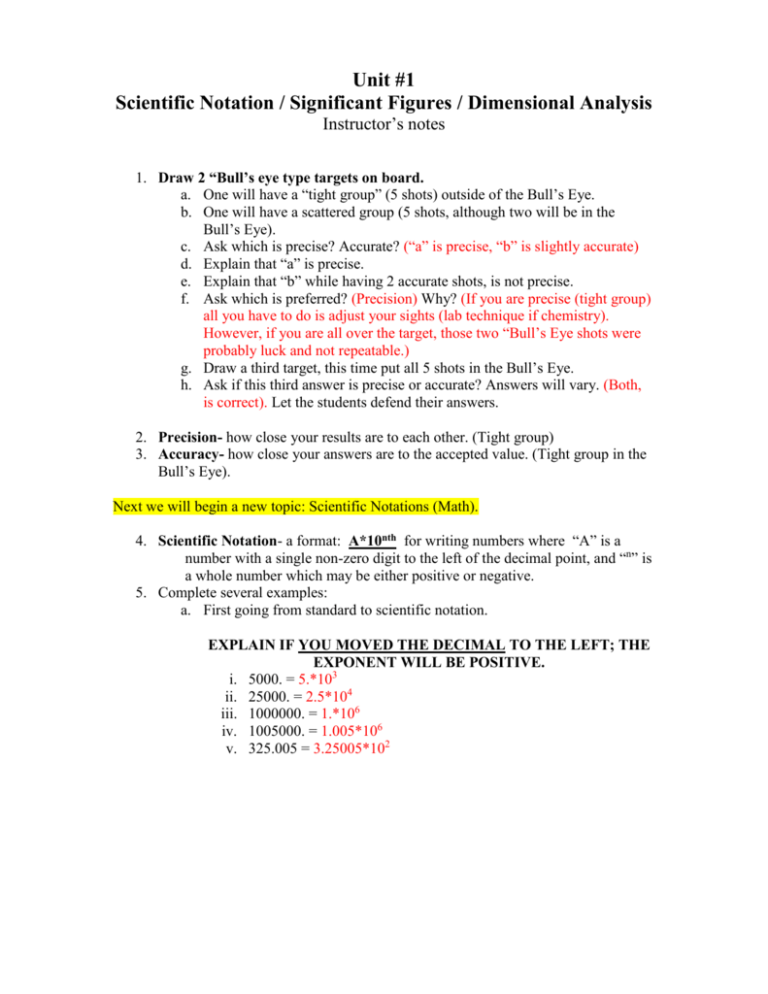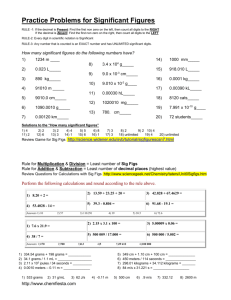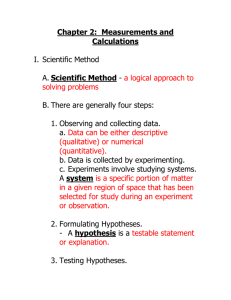Unit 1 - Wikispaces
advertisement

Unit #1 Scientific Notation / Significant Figures / Dimensional Analysis Instructor’s notes 1. Draw 2 “Bull’s eye type targets on board. a. One will have a “tight group” (5 shots) outside of the Bull’s Eye. b. One will have a scattered group (5 shots, although two will be in the Bull’s Eye). c. Ask which is precise? Accurate? (“a” is precise, “b” is slightly accurate) d. Explain that “a” is precise. e. Explain that “b” while having 2 accurate shots, is not precise. f. Ask which is preferred? (Precision) Why? (If you are precise (tight group) all you have to do is adjust your sights (lab technique if chemistry). However, if you are all over the target, those two “Bull’s Eye shots were probably luck and not repeatable.) g. Draw a third target, this time put all 5 shots in the Bull’s Eye. h. Ask if this third answer is precise or accurate? Answers will vary. (Both, is correct). Let the students defend their answers. 2. Precision- how close your results are to each other. (Tight group) 3. Accuracy- how close your answers are to the accepted value. (Tight group in the Bull’s Eye). Next we will begin a new topic: Scientific Notations (Math). 4. Scientific Notation- a format: A*10nth for writing numbers where “A” is a number with a single non-zero digit to the left of the decimal point, and “n” is a whole number which may be either positive or negative. 5. Complete several examples: a. First going from standard to scientific notation. EXPLAIN IF YOU MOVED THE DECIMAL TO THE LEFT; THE EXPONENT WILL BE POSITIVE. i. 5000. = 5.*103 ii. 25000. = 2.5*104 iii. 1000000. = 1.*106 iv. 1005000. = 1.005*106 v. 325.005 = 3.25005*102 EXPLAIN IF YOU DO NOT MOVE THE DECIMAL; THE EXPONENT WILL BE ZERO. 0 vi. 3.5 = 3.5*10 vii. 1.835 = 1.835*100 EXPLAIN IF YOU MOVED THE DECIMAL TO THE RIGHT; THE EXPONENT WILL BE NEGATIVE. viii. 0.5 = 5.*10-1 ix. 0.05 = 5.*10-2 x. 0.008 = 8.*10-3 xi. 0.5003 = 5.003*10-1 Now do examples from scientific to standard notation EXPLAIN IF THE EXPONENT IS POSITIVE, YOU MOVE THE DECIMAL TO THE RIGHT. xii. 1.*104 = 10000. xiii. 6.*103 = 6000. xiv. 1.5*102 = 150. xv. 3.55*105 = 355000. EXPLAIN IF THE EXPONENT IS ZERO, YOU DO NOT MOVE THE DECIMAL. 0 xvi. 4.11*10 = 4.11 xvii. 5.*100 = 5. xviii. 4.5678*100 = 4.5678 EXPLAIN IF THE EXPONENT IS NEGATIVE, YOU MOVE THE DECIMAL TO THE LEFT. xix. 6.7*10-4 = 0.00067 xx. 7.707*10-2 = 0.07707 xxi. 7.0031*10-1 = 0.70031 xxii. 1.00*10-2 = 0.0100 Next we will begin another new topic: Significant Figures (More math). 6. Significant Figure- those digits in a measured number (or the result of calculations with measured numbers) that include all certain digits plus a final digit with some uncertainty. 7. Certain Digit- a number whose value is measurable with the available equipment. 8. Uncertain digit- a number whose value is not known to be exact. The last digit of a measured number (excluding “counting”). The last digit of a rounded number. 9. Example: Somebody’s “old fashioned” bathroom scale indicates that the person weighs 180 lbs., however the needle lines up a wee bit above the actual 180 lb. mark. Does this person weigh exactly 180 lbs.? No The last digit is uncertain. How much does he weigh? Answers will vary. Again relate to uncertainty in a measurement. How can better determine this person’s weight? A more precise scale. Again relate to uncertain values. 10. Same as above, but, use a digital scale this time. 11. Rules for determining significant figures: a. All significant numbers must have a decimal point. b. Every non-zero digit in a recorded measurement is significant. i. 54.3 mL = 3 sig.figs. ii. 0.123 g = 3 sig.figs iii. 156. m = 3 sig.figs c. Zeros appearing between non-zero digits are significant. i. 2304 m = 4 sig. figs. ii. 50.05 g = 4 sig. figs. iii. 12300.09 cm3 = 7 sig. figs. d. Zeros at the end of a number and to the right of the decimal point are always significant. i. 38.50 Km = 4 sig. figs. ii. 2.0900 g = 5 sig. figs. iii. 10000.00 v = 7 sig. figs. e. Zeros appearing in front of all non-zero digits are NOT SIGNIFICANT (they are place holders). i. 0.0067 mL = 2 sig. figs. ii. 0.25 mg = 2 sig. figs. iii. 0.000015 L = 2 sig. figs. f. Zeros at the end of a number and to the left of the decimal point are not significant if they are just place holders (no decimal or not measured). i. 400 cm = 1 sig. fig. ii. 35700 m = 3 sig. figs. iii. 3460 mm = 3 sig. figs. NOTICE THE LACK OF DECIMAL IN THE ABOVE EXAMPLES. THESE ARE ACTUALLY “UNCERTAIN” NUMBERS. g. EXCEPTIONS: The following situation have an unlimited number of significant figures: i. If counting: 25 students in this classroom means exactly 25 students. ii. Exactly defined quantities (conversion factors: 1in = 2.54cm.) New topic: Calculations with significant figures. 12. 13. When adding or subtracting significant figures, do the math. However, when reporting your answer the amount of significant figures will be equal to no more digits to the right of the decimal as the least amount of digits to the right of the decimal in the problem. (think place values) a. 234.5 14.75 + 6.795 256.045 However the answer would only 1 digit to the right of the decimal point. Therefore it would be 256.0 Note if the “4” were a five, we would have rounded up to 256.1. b. 123.416 34.67 + 7.9___ 165.986 This time the answer should be reported as: 166.0 Notice the effect of rounding. When multiplying or dividing significant figures, do the math. However, when reporting your answer the amount of significant figures will be equal to the least (lowest) number of significant figures that went into the problem. a. 14.7 * 0.0325 = 0.47775 However how many sig. figs. Can we have? 3 What will the correct answer be? 0.478. b. 101.325 / 760. = 0.1333223684??? However how many sig. figs. Can we have? 3 What will the correct answer be? 0.133. c. REMEMBER ORDER OF OPPERATIONS. Mult. / Div. / Add. / Sub. Each time you switch from mult/div. to add/sub; the rules above take effect for the respective operation. i. (5.809 * 7.34) / (0.0087 – 5.0) = (calc.) -8.542475908 42.63806 / -4.9913 42.6 / -5.0 = (sig. figs.) -8.5 New topic: “SI Base Units” 14. SI- International system of units – Revised version of the metric system. Made up of seven base units from which all others are derived. a. Base units i. Length meter m ii. Mass kilogram Kg iii. Time second s iv. Electric current ampere A v. Temperature Kelvin K 0 Celsius C vi. Amount of substance mole mol vii. Luminous intensity candela cd b. Derived units i. Volume ii. Density cubic meter Liter grams / cubic centimeter Grams / milliliter m3 L g/cm3 g/mL Density is symbolized by the Greek letter The formula is mass / volume. iii. Pressure iv. Area Pascal Atmosphere Millimeter of Mercury Square meter Pa Atm mm Hg m2 15. The “Conversion Line”- a method to help with conversion of one metric unit to another. Base m,g,L To use the above: start with the unit you know, determine how many "places" you must move to get the unit you desire, then move your decimal in that direction, that many places. Example #1: to convert 20.0 mm into Km; you would move the decimal 6 places to the left. This would be equal to 0.000020 Km. Example #2: to convert 123.0 L into mL; you would move the decimal 3 places to the left. This would be equal to 123000. mL 16. There are two formulas to convert between degrees Celsius and Kelvin. a) K = C + 273.15 b) C = K - 273.15 c) The relationship is as follows (temps refer to water): 0 K 373K BOIL 273K FREEZE 0K ABSOLUTE ZERO 1000C 00C -2730C C New topic: Dimensional Analysis. 17. Dimensional Analysis- A technique used to convert and combine numbers with like and different units. This method is especially useful to solve "story" problems like the ones we will frequently see in Chemistry. a) This technique simply requires you to "set up" and then "multiply and convert" fractions with the units that you are working. i) Example: 1500. mL = "?" L To solve set up as follows: 1500. mL * (1 L / 1000 mL) = 1.5 L Notice the unit we started with was on the left side of the problem. The unit we wanted was in the numerator of the "conversion unit", the unit we wanted to leave was in the denominator. ii) You may use as many "conversion units" as necessary. iii) Example how long is a million seconds? 1,000,000 sec * (1 min / 60 sec) * (1 hr / 60 min) * (1 day / 24 hr) = 11.57 days. iv) Example: According to the National Debt Clock the national debt is (visit web site: nationaldebtclock.com) "X" trillion of dollars. How long until 1 trillion seconds pass? 1,000,000,000,000 sec * (1 min / 60 sec) * (1 hr / 60 min) * (1 day / 24 hr) * (1 yr / 365 day) = 31,709 yrs. & 9.5 months. = 3170 decades = 317 centuries. 18. Conversion Factor- A ratio, including the units, set up as a fraction and used to solve "Chemistry problems.







